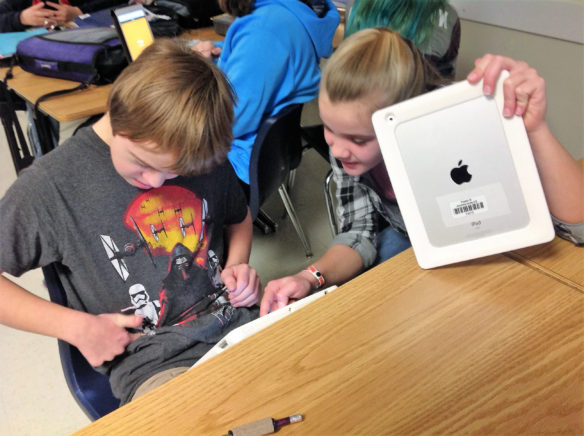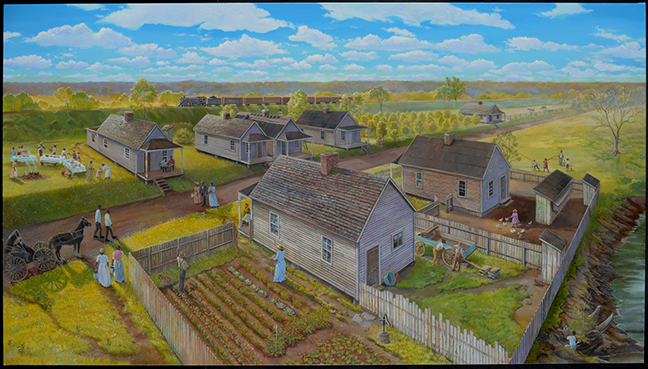
Tarin Ackerman and Abigail Slade, both 8th-graders in Angel Justice’s social studies class at East Jessamine Middle School (Jessamine County) play a game of Kahoot to review for a test. Justice pairs students with disabilities with other students in her classes as a way to foster independence and academic growth.
Submitted photo by Ellen Bloyd, Jan. 24, 2016
By Ellen Bloyd
Ellen.bloyd@jessamine.kyschools.us
Each day in Jessamine County Schools, more than 8,000 students come together to attend classes, eat lunch and socialize, among other things. Some of these students happen to have moderate to severe disabilities (MSD).
These students are included throughout the day in general education classes, along with their same-age peers. Often, general education teachers may need some assistance to meet the specific needs of students in their classroom who have MSD.
At East Jessamine Middle School, our students with MSD attend several core classes with their peers, including social studies. Social studies can be a class that is both interactive and enjoyable for all students. There are many opportunities for students to work in groups and connect with others, use technology, and learn about our history and culture together.
However, what if the social studies teacher has no experience working with students with disabilities? What does this type of classroom look like and how can the special education and general education teachers support one another?
One concern of general education teachers is what to do when a student with MSD is placed in their class. According to the East Jessamine Middle School’s Casey Plouffe – who serves as the curriculum resource administrator and is a former social studies teacher, students with MSD should be, “fully incorporated in the class and engaged in the content at their ability level so they can participate anytime.”
In order for students with MSD to be successful in the general education setting, thoughtful planning and preparation between the general and special education teachers is required.
Ideally, the social studies teacher and the special education teacher collaborate before the start of each school year to outline expectations for all students and the content being taught for the year. During this time, the special education teacher can provide information about his/her student(s) that is beneficial in helping the general education teacher understand how to best incorporate supports into the instructional activities, communicate with the student, manage student behavior and fairly grade a student with MSD.
For example, if a student is nonverbal or uses a communication device, the special education teacher can provide training about how to use the device, demonstrate how the student uses the device to communicate or show how use of the device could allow for the student to interact and participate more within the classroom. If the student has a behavior of concern, the special education teacher should share the student’s behavior plan with the social studies teacher, indicating suggestions of how to address those behaviors if they occur during class time.
Additionally, a student with moderate to severe disabilities may not be completing assignments at the same level of complexity or difficulty as their peers without disabilities. Therefore, the student may have different achievement expectations that require teachers to think differently about grading. If students with MSD have a separate grading rubric, special education teachers should share that rubric so the general education teacher will be able to grade the students appropriately.
Generally, assignments need to be modified to meet the individual needs of each student with MSD. The social studies teacher and special education teacher should identify the content each special needs student should be focusing on for each unit.
“When we look at the lesson, we look for the big idea,” said Lou-Ann Land from the Kentucky Peer Support Network Project, which is a project through the University of Kentucky Human Development Institute that focuses on building relationships between students with and without disabilities inside or outside of the classroom setting. “What is the most important piece of information or salient concept that the student needs so that he or she has enough background information to continue in the next day’s lesson?”
The social studies teacher should provide the special education teacher with materials (i.e. worksheets, tests, quizzes, bell ringers, notes, etc.) in advance so the materials can be modified to meet individual students’ strengths and needs. After the initial meeting at the beginning of the year, the teachers should continue to collaborate and meet intermittently throughout the year. Some teachers may like to meet at the beginning of each unit to outline what the expectations are, some may prefer to meet once per week or even daily.
More often than not, students with MSD attend core content and elective classes accompanied by an instructional assistant or occasionally the special education teacher. While the instructional assistant is there primarily to assist the students with disabilities, the instructional assistant should be able to float around the room and assist all students, as well as the general education teacher.
In order to foster independence, the instructional assistant should not sit by the student or students they are accompanying. By doing so, the adult unintentionally creates a barrier between the student(s) with disabilities and the students without disabilities. Peers and often the general education teacher tend to go through the instructional assistant or special education teacher to communicate with the student(s) with disabilities.
“Ideally, you should be able to walk into a general education classroom and have no idea if a student has an Individualized Education Plan or not,” said Sarah Whitfield, the MSD consultant with Jessamine County Schools.
One way to eliminate barriers and integrate all students is to facilitate interactions by pairing MSD students with a peer who is able to keep up with the daily class work while assisting another student or a small group of peers within the general education classes. Through East Jessamine’s participation in the Kentucky Peer Support Network Program, we hope to build friendships between students with and without disabilities not only within the classroom setting, but outside of the classroom. These interactions encourage communication and socialization between students and allows for students with disabilities to first rely on their peers for academic support rather than automatically relying on the assistant.
It is best for general education teachers and special education teachers to plan and prepare together before the beginning of and throughout the year so that each day there are appropriate lessons prepared for MSD students that connect to the same lesson other students in the class are doing. Ultimately, the team of the general and special education teachers and the instructional assistants work together in the best interest of all students. A team approach requires constant open communication and sharing of ideas and resources.
Ellen Bloyd is an MSD teacher at East Jessamine Middle School (Jessamine County). She is in her 11th year of teaching students with moderate to severe disabilities. She has a master’s degree in special education from the University of Kentucky.



Leave A Comment